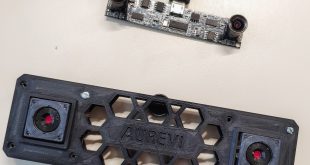Caroline Rizza, Télécom Paris – Institut Mines-Télécom As part of my research into the benefits of digital technologies in crisis management and in particular the digital skills of those involved in a crisis (whether institutions or grassroots citizens), I had the opportunity to shadow the Fire and Emergency Department of the Gard (SDIS) in Nîmes, from 9 to 23 April …
Read More »Search Results for: 3D
Aerosol therapy: An ex vivo model of lungs
A researcher in Health Engineering at Mines Saint-Étienne, Jérémie Pourchez, and his colleagues at the Saint-Étienne University Hospital, have developed an ex vivo model of lungs to help improve medical aerosol therapy devices. An advantage of this technology is that scientists can study inhalation therapy whilst limiting the amount of animal testing that they use. This article is part …
Read More »Bone implants to stimulate bone regeneration
Mines Saint-Étienne’s Centre for Biomedical and Healthcare Engineering (CIS) seeks to improve healthcare through innovations in engineering. David Marchat, a materials researcher at CIS, is working on developing calcium phosphate-based biomaterials. Due to their ability to interact with living organisms, these bone implants can help regenerate bones. This article is part of our dossier “When engineering helps improve healthcare“ …
Read More »An autonomous contact lens to improve human vision
Two teams from IMT Atlantique and Mines Saint-Étienne have developed an autonomous contact lens which is powered by an integrated flexible micro-battery. This invention is a world first that opens new health prospects, whilst also opening the door for scientists to develop other human-machine interfaces. Human augmentation, a field of research that aims to enhance human abilities through technological …
Read More »Romain Quey, all about polycrystals
A recent winner of a CNRS Bronze medal, Romain Quey is a materials science researcher at the Georges Friedel[1] laboratory at Mines Saint-Étienne. He focuses especially on the deformation of metallic polycrystalline materials. In the following interview for I’MTech, he presents his research, between synchrotron radiation and digital simulation. Could you define what a polycrystalline material is? Romain …
Read More »Virtual reality improving the comfort of people with visual impairments
People suffering from glaucoma or retinitis pigmentosa develop increased sensitivity to light and gradually lose their peripheral vision. These two symptoms cause discomfort in everyday life and limit the social activity of the people affected. The AUREVI research project involving IMT Mines Alès aims to improve the quality of life of visually-impaired people with the help of a virtual reality headset. …
Read More »Without noise, virtual images become more realistic
With increased computing capacities, computer-generated images are becoming more and more realistic. Yet generating these images is very time-consuming. Tamy Boubekeur, specialized in 3D Computer Graphics at Télécom ParisTech, is on a quest to solve this problem. He and his team have developed new technology that relies on noise-reduction algorithms and saves computing resources while offering high-quality images. Have …
Read More »Digital twins in the health sector: mirage or reality?
Digital twins, which are already well established in industry, are becoming increasingly present in the health sector. There is a wide range of potential applications for both diagnosis and treatment, but the technology is mostly still in the research phase. The health sector is currently undergoing digital transition with a view to developing “4P” treatment: personalized, predictive, preventive and …
Read More »User immersion, between 360° video and virtual reality
I’MTech is dedicating a series of success stories to research partnerships supported by the Télécom & Société Numérique (TSN) Carnot Institute, which the IMT schools are a part of. To better understand how users interact in immersive environments, designers and researchers are comparing the advantages of 360° video and full-immersion virtual reality. This is also the aim of the TroisCentSoixante …
Read More »Technology that decrypts the way our brain works
Different techniques are used to study of the functioning of our brain, including electroencephalography, magnetoencephalography, functional MRI and spectroscopy. The signals are processed and interpreted to analyze the cognitive processes in question. EEG and MRI are the two most commonly used techniques in cognitive science. Their performances offer hope and but also concern. What is the current state of affairs …
Read More » I'MTech L'actualité scientifique et technologique de l'IMT
I'MTech L'actualité scientifique et technologique de l'IMT









